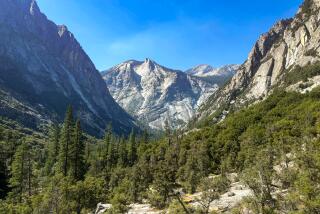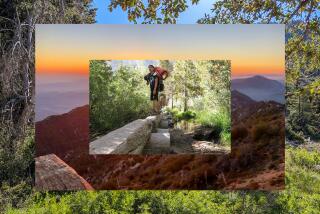In fall, experience the awe and adventure in Sequoia and Kings Canyon national parks
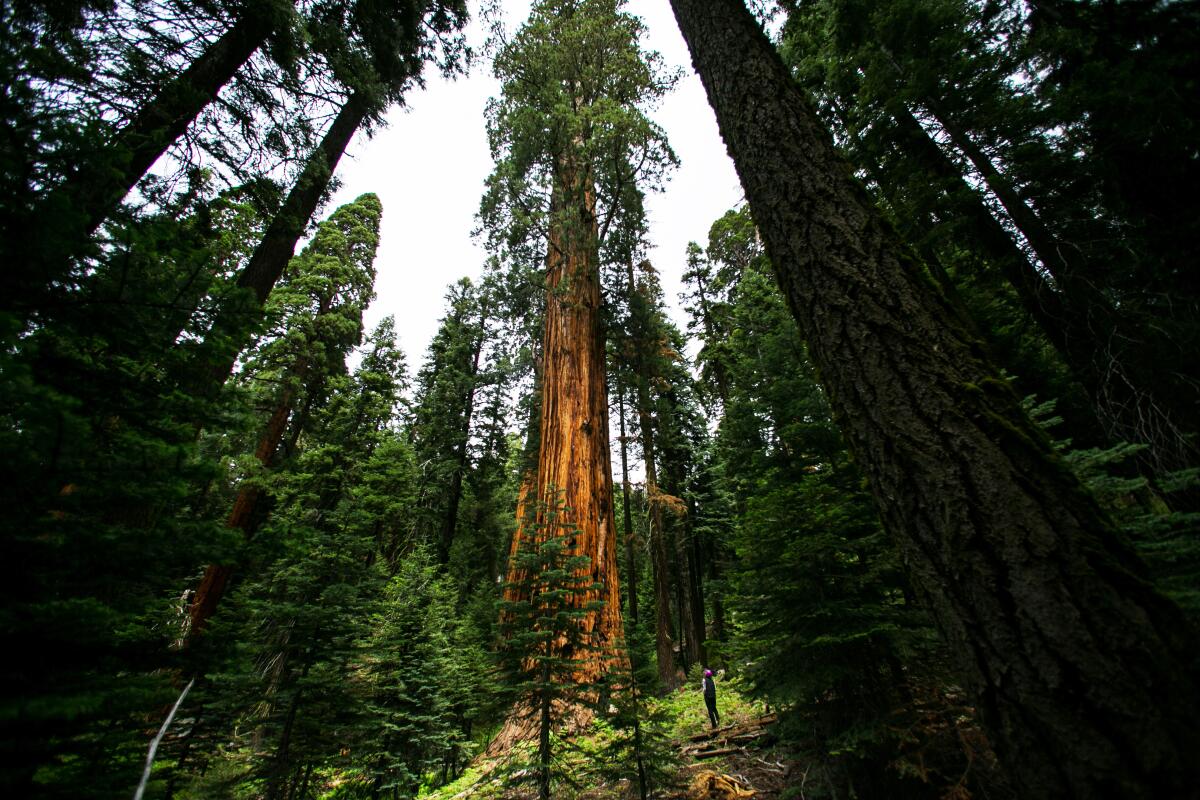
- Share via
THREE RIVERS, Calif. — The giant trees of Sequoia National Park will fill you with awe — and give you a crick in your neck from staring up at them.
The wild backcountry of Kings Canyon National Park will bring you over-the-top adventure — and muscle cramps from walking too far with a 35-pound pack on your back.
But who cares about a little pain when the payoff is so grand? These two incredible parks, only a four- to five-hour drive from Los Angeles, are practically in our backyard. And guess what? The high season ends Sept. 8, meaning the time is right for a budget visit.
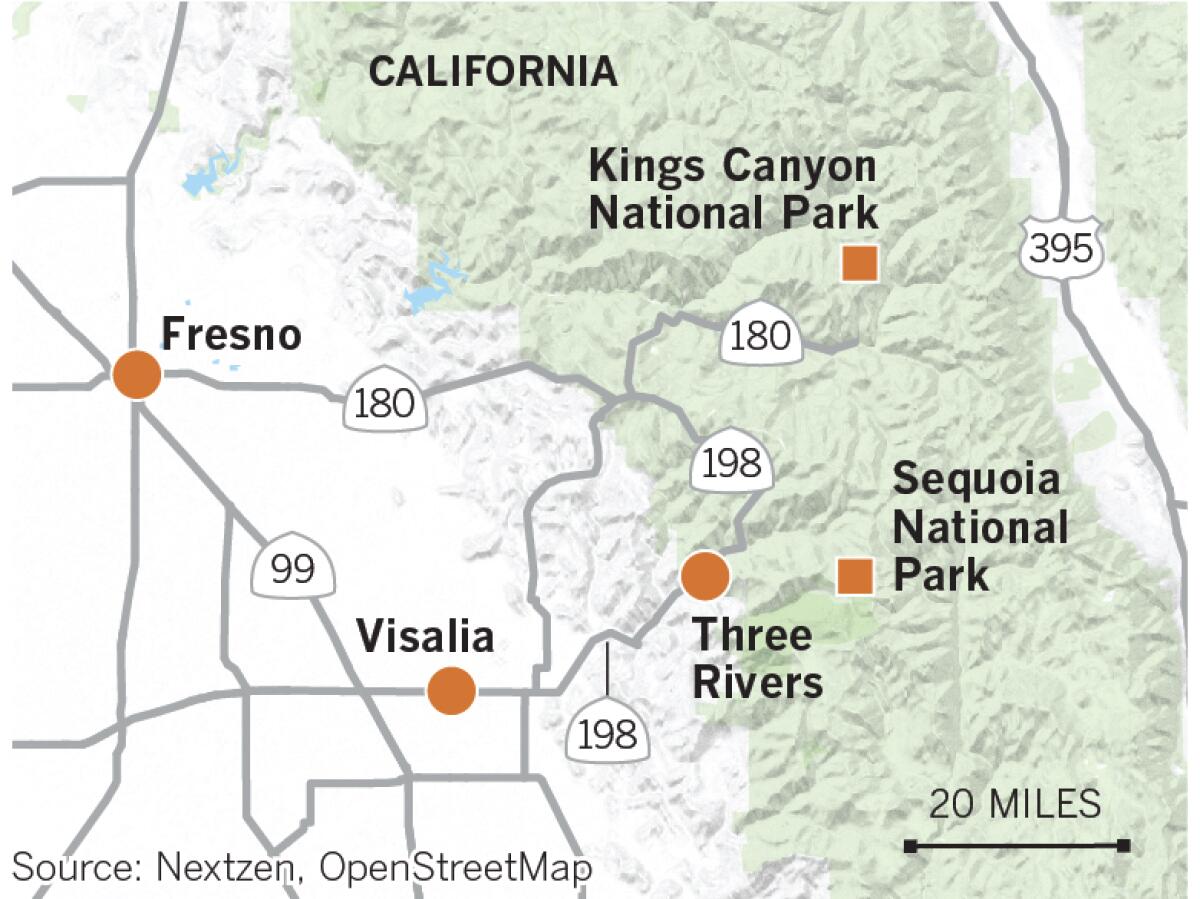
Hotel rooms that cost $300 to $400 a night will be less than $200. Some, such as John Muir Lodge in Kings Canyon, have rates as low as $105 a night.
And the campgrounds that were always full during the summer now have vacancies. Pitch your tent, set up a couple of camp chairs and enjoy the bounty of a late summer or early fall mini-vacay along the rushing Kings River. Campsites are just $12 to $22 per night in the parks.
Saving money isn’t the only benefit. Shoulder-season visitors (September-November) avoid the hustle and bustle of peak times. Traffic lessens, autumn leaves appear and it becomes easy to find a parking spot.
The weather also cools off, a big plus. Many days here top 100 degrees during the summer. Weather like that is brutal if you’re hiking — or even just taking a quarter-mile nature walk with the kids. Skip the sizzling July and August weather and visit in October when average highs are in the 60s.
November is a little chancier: I was here last year in mid-November and encountered a snowstorm that cut short my hiking plans. But, to be honest, I’m not an all-weather hiker; I’m a pleasant-stroll-on-a-pleasant-day kind of hiker.
A couple of other problems also arise if you visit too late in the year. The road to Kings Canyon’s Cedar Grove area will close Nov. 11. And you don’t want to miss that spectacular area of the park. Many campgrounds also close. But I’m getting a little ahead of myself.
Grander than Yosemite
Let’s start when naturalist John Muir wrote about the area that eventually became Sequoia National Park and Kings Canyon National Park.
“In the vast Sierra wilderness south of the famous Yosemite Valley,” Muir wrote in 1891, “there is a yet grander valley of the same kind.”
Grander than Yosemite? Those are strong words. But many park fans agree. Sequoia has the largest trees on the planet and Mt. Whitney, the highest point in the Lower 48. Kings Canyon is by some measures considered the deepest canyon in the country.
It’s a place that can make visitors feel very small. It also can bring a sense of tranquility to complicated lives.
The adjacent parks, which are administered together, offer beautiful rivers and waterfalls, lush valleys, vast caverns, snow-capped peaks and terrain ranging from 1,300 to 14,500 feet. And it’s all in the southern Sierra Nevada, a 225-mile drive from Los Angeles.
“I’m biased,” said the parks’ superintendent, Woody Smeck, “but being a park ranger at Sequoia and Kings Canyon is the best job on the planet.
“Nowhere else in the national park system can you experience the diversity of landscapes within a day’s hike, from blue oak woodlands to red fir forests to alpine tundra,” Smeck added. Plus, of course, “the stunning ancient giant sequoia groves.”
Nearly 2 million people visit annually, with the largest concentration in the summer. That number included photographer Jim Edwards and me, who visited this year during the July rush.
It wasn’t pretty: Cars parked every which way on the side of the road, overflowing campgrounds and restaurants turned away customers because they had run out of food, and hotel lodging was two to three times more expensive than when we visited in the fall.
Nonetheless, the parks were wonderful. Not exactly monuments to serenity, but still beautiful.
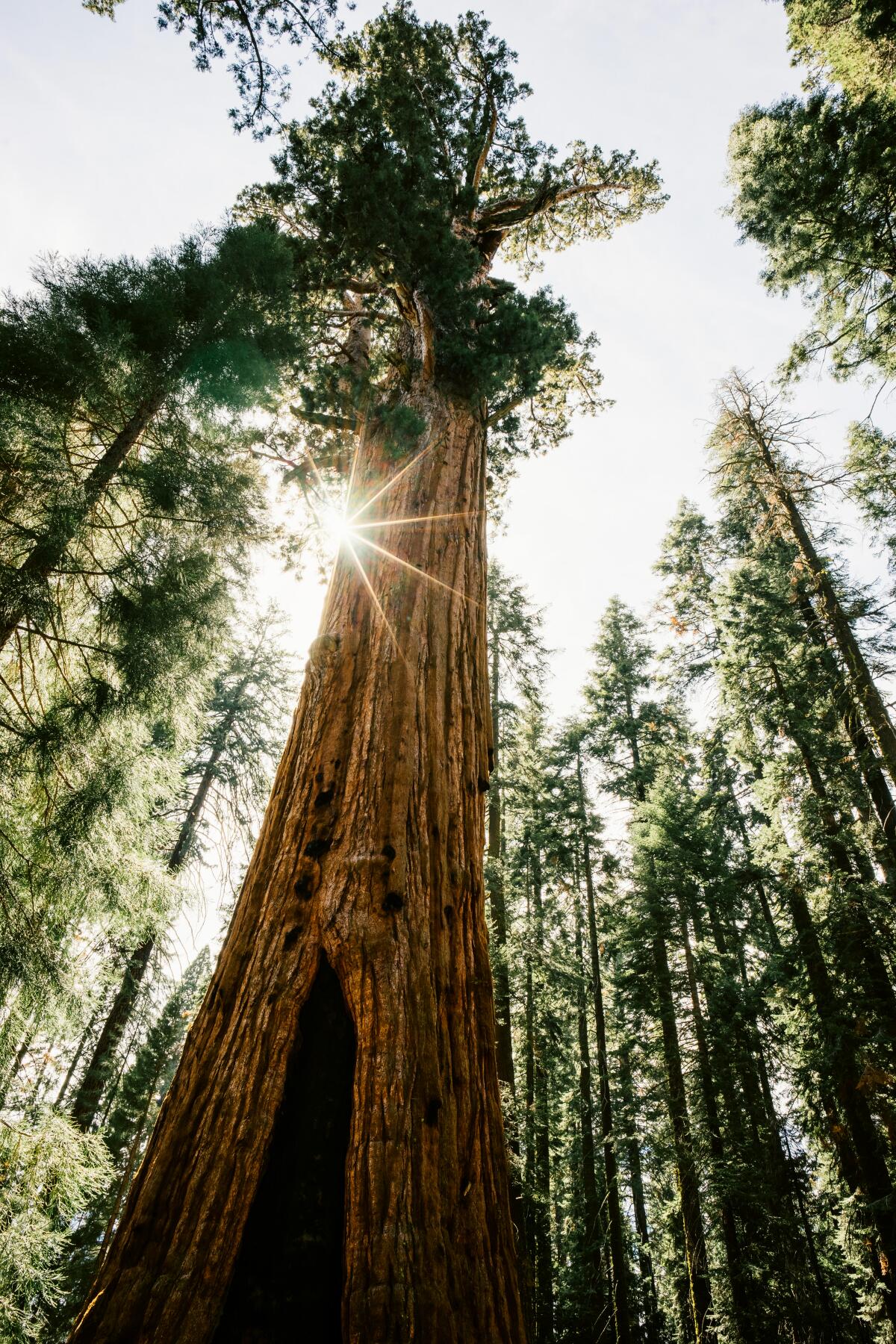
The sequoias were as impressive as ever, even surrounded by a gaggle of visitors. The colossal trees can grow as tall as a 26-story building and live more than 3,000 years, thanks to a chemical in their bark that protects against rot, boring insects and even fire.
It’s hard to comprehend the size of a sequoia until you stare up at one, especially the General Sherman Tree, a giant among giants — 275 feet tall and more than 36 feet in diameter. It’s the largest tree in the world by volume and is a favorite stop for visitors. Yes, you’ll have to walk half a mile to see it, but it’s a pilgrimage you’ll remember the rest of your life.
Even better: Take the 2-mile Congress Trail, which begins at the General Sherman Tree and loops through the heart of the green and beautiful Giant Forest, home to more than 2,000 sequoias with trunk diameters greater than 10 feet. It’s an easy trail and, like the Sherman Trail, is both wheelchair- and kid-friendly.
Another highlight of Sequoia National Park is Moro Rock, which isn’t an easy trail. If the walk to General Sherman fazes, Moro Rock will stop you in your tracks. The bald granite dome looms thousands of feet above the park highway, protruding from a forested ridge 6,725 feet above sea level.
The challenge is to climb this monolith. The trail is only a quarter mile, with a series of ramps, staircases and rest areas built into the rock’s face.
I liked the rest areas more than the 400 steps and spent most of my time at them thinking about whether I was going to quit or keep climbing. Meanwhile, toddlers and 80-year-olds streamed by on their way to the top. Edwards was way ahead of me, photographing climbers celebrating their successful ascents.
I stopped to admire the view of the Kaweah River gorge far below and the zigzagging switchbacks of the Generals Highway as it headed south toward Three Rivers, a resort community at the entrance to the park.
Another rest spot gave me a chance to see the Great Western Divide of the High Sierra, a jagged wall of stunning peaks still snow-capped in July. The Sierra Nevada is more than 400 miles long and 60 to 80 miles wide, larger than the French, Swiss and Italian Alps combined.
Just as I was about to climb again, Edwards came down from the top and wanted to leave. Darn.
Drive the scenic byway
The next day we headed deep into Kings Canyon National Park, a rugged landscape of granite, water and sky. Like Sequoia, more than 95% is wilderness and few roads disturb the peace.
A small section of Kings Canyon lies near the California 180 Big Stump entrance to the park, where the visitor center, lodging and Grant Grove can be found.
But the exciting portions of this park are miles away on 180, also called the Kings Canyon Scenic Byway. We couldn’t visit in November because the road had closed.
But in July, we could follow the highway as it zigzagged east for 30 miles, skirting the banks of the roaring Kings River. We stopped frequently, at Junction View and other highway pulloffs that offer breathtaking overlooks into Kings Canyon.
It’s scenery like this that draws the park’s most ardent fans. Candy Wood, a Long Beach resident, has been visiting for 50 years and celebrated her park anniversary in August with a family campout “and a chocolate cherry cake made in a cast-iron pot.”
Her crew loves “hiking and camping and playing in the river.”
At Boyden Cavern, we took an hourlong guided tour through a colorful cave full of stalactites, stalagmites, a creek and various rock formations. (Open until mid-November, $16 for adults.)
There was a steep climb to the entrance, then various places in which we had to stoop low or shimmy to inch our way along a pathway that was sometimes only 3 feet high and 12 inches wide.
Our guide called these hallways “headache makers,” and I quickly realized why as I repeatedly clonked my head on low-hanging rocks. Edwards, despite being tall, seemed immune until we rounded our last turn and I heard a loud thump and an “Ugh.”
I liked the 54-degree temperature inside the cavers, but I didn’t like the bumps. Next time we’ll return with helmets. We walked to the the car and hit the road again.
We were rapidly approaching Roads End, the eastern terminus of the scenic byway. But first a surprise: Grizzly Falls, a magical waterfall just off the highway. The 75-foot fall was thunderously strong when we visited and is only about a tenth of a mile off the road.
Six miles past tiny Cedar Grove Village, the road ends and the wilderness begins. If you want to continue any farther than this, you have to walk. Maybe next time—I was still dizzy from Boyden Cavern.
If you go
THE BEST WAY TO SEQUOIA AND KINGS CANYON NATIONAL PARKS
From Los Angeles: Take Interstate 5 north to California 99 north toward Bakersfield/Fresno. Take exit 96 onto California 198 east toward Visalia. Continue to the Ash Mountain entrance of Sequoia National Park. Or take California 180 east from Fresno to the Big Stump entrance of Kings Canyon National Park.
WHERE TO STAY
John Muir Lodge, California 180, Grant Grove Village, Kings Canyon National Park, Calif.; (866) 807-3598. Handsome log lodge, built in 1998, is in a forest setting and close to a restaurant, forest service center and gift shop. Doubles from $105 per night.
Buckeye Tree Lodge, 46000 Sierra Drive, Three Rivers, Calif.; (559) 561-5900. Watch the river roll by from your patio or balcony at this lodge just a quarter of a mile from the entrance to Sequoia National Park. A sister property, Sequoia Village Inn, is next door and has cabin-style units. From $179 per night, double occupancy.
Best Western Americana, 1450 S. Alta Ave., Dinuba, Calif.; (800) 780-7234. This tidy hotel is an inexpensive place to stay on holidays and other times when everything closer to the park is booked. It’s a 45-minute drive from the park but offers good rates, a pool and free breakfast. Doubles from $119 per night.
National Parks campgrounds that accept reservations are accessible at (877) 444-6777, recreation.gov
WHERE TO EAT
Grant Grove Restaurant, Grant Grove Village, Kings Canyon National Park; (559) 335-5500. This recently redesigned restaurant is the best option for a sit-down meal in the parks. Typical American fare, including sandwiches, burgers, salads, pastas, chicken and trout. Entrees $11-$30.
Gateway Restaurant and Lodge, 45978 Sierra Drive, Three Rivers, Calif.; (559) 561-4133. This old-school restaurant at the entrance to Sequoia National Park serves up great river views with its steaks and seafood. Dinner entrees $13-$85.
Sierra Subs and Salads, 41717 Sierra Drive, Three Rivers, Calif.;(559) 561-4810. Great sandwiches, salads and subs Salads and subs, $4-$12, pizzas $12-$18. Closed Mondays.
TO LEARN MORE
Sequoia and Kings Canyon National Parks
Lodging and tours inside the parks
More to Read
Sign up for The Wild
We’ll help you find the best places to hike, bike and run, as well as the perfect silent spots for meditation and yoga.
You may occasionally receive promotional content from the Los Angeles Times.

